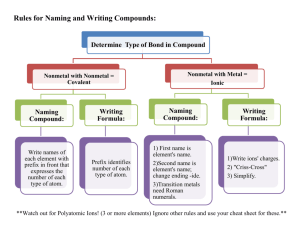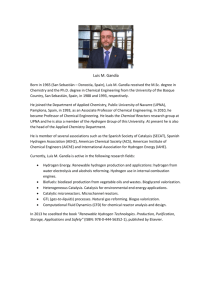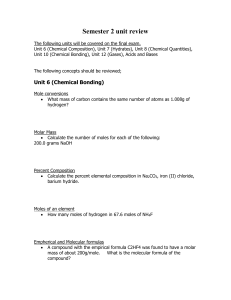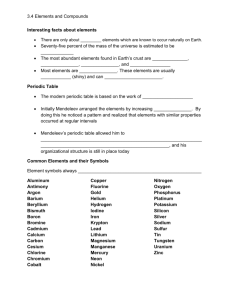Stochastic optimization in hydrogen distribution network
advertisement
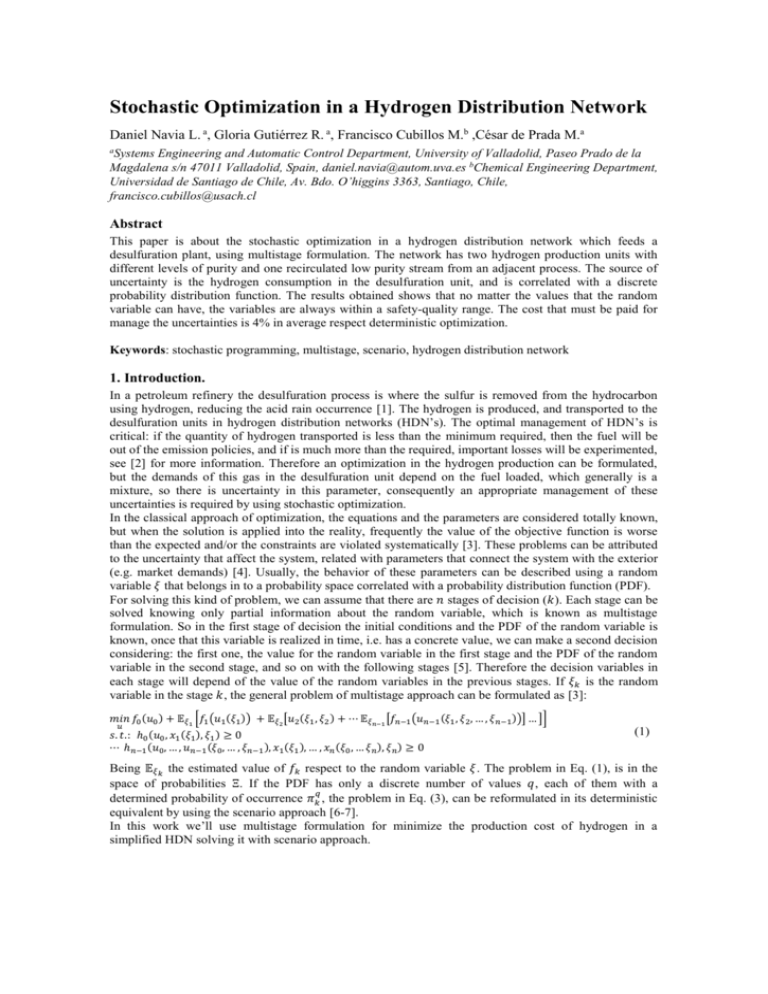
Stochastic Optimization in a Hydrogen Distribution Network Daniel Navia L. a, Gloria Gutiérrez R. a, Francisco Cubillos M.b ,César de Prada M.a a Systems Engineering and Automatic Control Department, University of Valladolid, Paseo Prado de la Magdalena s/n 47011 Valladolid, Spain, daniel.navia@autom.uva.es bChemical Engineering Department, Universidad de Santiago de Chile, Av. Bdo. O’higgins 3363, Santiago, Chile, francisco.cubillos@usach.cl Abstract This paper is about the stochastic optimization in a hydrogen distribution network which feeds a desulfuration plant, using multistage formulation. The network has two hydrogen production units with different levels of purity and one recirculated low purity stream from an adjacent process. The source of uncertainty is the hydrogen consumption in the desulfuration unit, and is correlated with a discrete probability distribution function. The results obtained shows that no matter the values that the random variable can have, the variables are always within a safety-quality range. The cost that must be paid for manage the uncertainties is 4% in average respect deterministic optimization. Keywords: stochastic programming, multistage, scenario, hydrogen distribution network 1. Introduction. In a petroleum refinery the desulfuration process is where the sulfur is removed from the hydrocarbon using hydrogen, reducing the acid rain occurrence [1]. The hydrogen is produced, and transported to the desulfuration units in hydrogen distribution networks (HDN’s). The optimal management of HDN’s is critical: if the quantity of hydrogen transported is less than the minimum required, then the fuel will be out of the emission policies, and if is much more than the required, important losses will be experimented, see [2] for more information. Therefore an optimization in the hydrogen production can be formulated, but the demands of this gas in the desulfuration unit depend on the fuel loaded, which generally is a mixture, so there is uncertainty in this parameter, consequently an appropriate management of these uncertainties is required by using stochastic optimization. In the classical approach of optimization, the equations and the parameters are considered totally known, but when the solution is applied into the reality, frequently the value of the objective function is worse than the expected and/or the constraints are violated systematically [3]. These problems can be attributed to the uncertainty that affect the system, related with parameters that connect the system with the exterior (e.g. market demands) [4]. Usually, the behavior of these parameters can be described using a random variable 𝜉 that belongs in to a probability space correlated with a probability distribution function (PDF). For solving this kind of problem, we can assume that there are 𝑛 stages of decision (𝑘). Each stage can be solved knowing only partial information about the random variable, which is known as multistage formulation. So in the first stage of decision the initial conditions and the PDF of the random variable is known, once that this variable is realized in time, i.e. has a concrete value, we can make a second decision considering: the first one, the value for the random variable in the first stage and the PDF of the random variable in the second stage, and so on with the following stages [5]. Therefore the decision variables in each stage will depend of the value of the random variables in the previous stages. If 𝜉𝑘 is the random variable in the stage 𝑘, the general problem of multistage approach can be formulated as [3]: 𝑚𝑖𝑛 𝑓0 (𝑢0 ) + 𝔼𝜉1 [𝑓1 (𝑢1 (𝜉1 )) + 𝔼𝜉2 [𝑢2 (𝜉1 , 𝜉2 ) + ⋯ 𝔼𝜉𝑛−1 [𝑓𝑛−1 (𝑢𝑛−1 (𝜉1 , 𝜉2 , … , 𝜉𝑛−1 ))] … ]] 𝑢 𝑠. 𝑡.: ℎ0 (𝑢0 , 𝑥1 (𝜉1 ), 𝜉1 ) ≥ 0 ⋯ ℎ𝑛−1 (𝑢0 , … , 𝑢𝑛−1 (𝜉0 , … , 𝜉𝑛−1 ), 𝑥1 (𝜉1 ), … , 𝑥𝑛 (𝜉0 , … 𝜉𝑛 ), 𝜉𝑛 ) ≥ 0 (1) Being 𝔼𝜉𝑘 the estimated value of 𝑓𝑘 respect to the random variable 𝜉. The problem in Eq. (1), is in the space of probabilities Ξ. If the PDF has only a discrete number of values 𝑞, each of them with a 𝑞 determined probability of occurrence 𝜋𝑘 , the problem in Eq. (3), can be reformulated in its deterministic equivalent by using the scenario approach [6-7]. In this work we’ll use multistage formulation for minimize the production cost of hydrogen in a simplified HDN solving it with scenario approach. Stochastic Optimization in a Hydrogen Distribution Network 2. Problem Formulation. Let’s consider a simplified structure of a HDN represented in Figure 1 that has one desulfuration unit (HD3), two hydrogen production units that produces with different levels of purities (H4 and H3), one low purity recirculated stream that came from other process (UNI), and collectors connecting the production and recirculation units with the desulfuration ones (CH4, CH3 and CBP). Undesulfurized Fuel m mkCH4_HD3(x1,…,xk) Desulfurized Fuel HD3 CHARGE(HD3,xk) mkHD3(x1,…,xk) mkCBP_HD3(x1,…,xk) mkCH3_HD3(x1,…,xk) PkCH4(x1,…,xk) CH4 PkCH3(x1,…,xk) CH3 mkCH4(x1,…,xk) mkCH3(x1,…,xk) uk(H4,CH4)(x1,…,xk) uk(H3,CH3)(x1,…,xk) H4 PkCBP(x1,…,xk) CBP H3 mkCBP(x1,…,xk) uk(UNI,CBP)(x1,…,xk) UNI Figure 1: Process flow sheet for a simplified HDN The HDN works in stationary state because is a continuous process, but due the uncertainties that affect the system, the problem formulation will be pseudo-stationary i.e.: for each decision stage, the hydrogen demand can change according to its PDF. Defining the following elements for the optimization: Sets · 𝑃𝑈: Production and recirculation units. · 𝐶𝑈: Consumption units. · 𝐶𝐿: Hydrogen Collectors. · 𝑆𝑇𝑅: Process streams. · 𝜉𝑘 : Random variable in each decision stage: 𝑘 = 1, … , 𝑛. · 𝑂𝑃𝑈(𝑃𝑈, 𝐶𝐿): Process streams that comes out from 𝑃𝑈 to 𝐶𝐿. · 𝑂𝐶𝐿(𝐶𝐿, 𝑆𝑇𝑅): Process streams that come out from 𝐶𝐿 to 𝐶𝑈. · 𝐼𝐶𝑈(𝐶𝑈, 𝑆𝑇𝑅): Process streams that come into 𝐶𝑈. Parameters 𝐿𝑂𝑊 𝑈𝑃 · 𝑄𝑃𝑈 , 𝑄𝑃𝑈 : Lower and Upper hydrogen molar flow production in each 𝑃𝑈 · 𝑥𝑃𝑈 Available hydrogen purity in each 𝑃𝑈 · 𝐶𝑃𝑈 : Cost of produce hydrogen in each 𝑃𝑈 𝐿𝑂𝑊 · 𝑥𝐶𝑈 Minimal mole fraction allowed for the desulfuration process. 0 · 𝑃𝐶𝐿 Initial pressure in 𝐶𝐿. 𝐿𝑂𝑊 𝑈𝑃 · 𝑃𝐶𝐿 , 𝑃𝐶𝐿 : Minimal and maximal pressures allowed respectively in each 𝐶𝐿. · 𝑉𝐶𝐿 , 𝑇𝐶𝐿 : Volume and temperature of the collectors. Uncertain Parameter 𝑘 (𝐶𝑈, 𝜉𝑘 ): Flow of hydrogen needed for the desulfuration in each stage. · 𝑚𝐶𝐻𝐴𝑅𝐺𝐸 Positive Variables · 𝑥𝑆𝑇𝑅 Hydrogen mole fraction in process streams. 𝑘 (𝜉 · 𝑚𝑆𝑇𝑅 1 , … 𝜉𝑘 ): Molar flow in process streams, upstream collectors, in stage 𝑘 = 1 … 𝑛. 𝑘 · 𝑢(𝑃𝑈,𝐶𝐿) (𝜉1 , … 𝜉𝑘 ): Molar flow produced in each 𝑃𝑈 to 𝐶𝐿, in the stage 𝑘 = 1 … 𝑛 − 1. 0 · 𝑢(𝑃𝑈,𝐶𝐿) : Molar flow produced in each 𝑃𝑈 to 𝐶𝐿, in the first decision stage. · 𝑥𝐶𝐿 Hydrogen mole fraction in 𝐶𝐿. 𝑘 (𝜉 · 𝑚𝐶𝐿 1 , … , 𝜉𝑘 ): Molar flow that come into each 𝐶𝐿, in the stage 𝑘 = 1, … , 𝑛 − 1. 0 · 𝑚𝐶𝐿 : Molar flow that come into each 𝐶𝐿, in the first decision stage. 𝑘 (𝜉 · 𝑃𝐶𝐿 1 , … , 𝜉𝑘 ): Pressure in 𝐶𝐿 at the end of the stage 𝑘 = 1, … , 𝑛. 𝑘 (𝜉 · 𝑥𝐶𝑈 1 , … , 𝜉𝑘 ): Hydrogen mole fraction of the stream that come into 𝐶𝑈, in the stage 𝑘 = 1, … , 𝑛 𝑘 (𝜉 · 𝑚𝐶𝑈 1 , … , 𝜉𝑘 ): Molar flow of the stream that come into 𝐶𝑈, in the stage 𝑘 = 1, … , 𝑛. Free Variables · 𝐴𝑘𝐶𝐿 (𝜉1 , … , 𝜉𝑘 ): Mole accumulation in each 𝐶𝐿, in stage 𝑘 = 1, … , 𝑛 𝑘 (𝐶𝐿, · Δ𝑛𝐶𝐿 𝜉1 , … , 𝜉𝑘 ): Quantity of mole accumulated in each 𝐶𝐿, in stage 𝑘 = 1, … , 𝑛 Stochastic Optimization in a Hydrogen Distribution Network Equations · Mole balance at the entrance of the collector: the molar flow entering in the collector is equal to the sum of molar flows that come from production units. 𝑘 𝑘 (𝐶𝐿, (𝜉1 , … , 𝜉𝑘 ) = 𝑚𝐶𝐿 ∑ 𝑢(𝑃𝑈,𝐶𝐿) 𝜉1 , … , 𝜉𝑘 ) 𝑈𝑃∈𝑂𝑃𝑈 0 0 (𝐶𝐿), ∑ 𝑢(𝑃𝑈,𝐶𝐿) = 𝑚𝐶𝐿 ∀𝐶𝐿, 𝑘 = 1, … , 𝑛 − 1 (2) 𝐶𝐿∈𝑂𝑃𝑈 · Mole balance in the collector: due the different values that the random variable can have, the mole balance in this unit is pseudo-stationary and the difference between the flows produced and consumed is the mole accumulation. 𝑘 (𝜉 𝑚𝐶𝐿 1 , … , 𝜉𝑘 ) − ∑ 𝑘+1 (𝜉 𝑘+1 𝑚𝑆𝑇𝑅 1 , … , 𝜉𝑘+1 ) = 𝐴𝐶𝐿 (𝜉1 , … , 𝜉𝑘+1 ) 𝑆𝑇𝑅 ∈ 𝑂𝐶𝐿 0 𝑚𝐶𝐿 − 1 (𝜉 ) 1 𝑚𝑆𝑇𝑅 1 = 𝐴𝐶𝐿 (𝜉1 ), ∀𝐶𝐿, 𝑘 = 1, … , 𝑛 − 1 ∑ (3) 𝑆𝑇𝑅 ∈ 𝑂𝐶𝐿 The mole accumulation formulated in Eq. (6) affects the pressure inside the collectors. The change in this variable is proportional to accumulation time 𝜃 and the difference between inner and outer flows. Ideal Gas Law is used (in operational conditions implies a maximal error of 2.5% [8]). 𝑘 (𝜉 𝑚𝐶𝐿 1 , … , 𝜉𝑘 ) − 0 𝑚𝐶𝐿 − ∑ 𝑆𝑇𝑅 ∈ 𝑂𝐶𝐿 ∑ 𝑉 𝐶𝐿 𝑘+1 (𝜉 𝑘+1 𝑘 𝑚𝑆𝑇𝑅 1 , … , 𝜉𝑘+1 ) = 𝜃𝑅𝑇 [𝑃𝐶𝐿 (𝜉1 , … , 𝜉𝑘+1 ) − 𝑃𝐶𝐿 (𝜉1 , … , 𝜉𝑘 )] 𝑆𝑇𝑅 ∈ 𝑂𝐶𝐿 𝑉𝐶𝐿 1 (𝜉 ) 1 𝑚𝑆𝑇𝑅 1 = 𝜃𝑅𝑇 [𝑃𝐶𝐿 (𝜉1 ) − 𝐶𝐿 𝐶𝐿 0 ], 𝑃𝐶𝐿 ∀𝐶𝐿, 𝑘 = 1, … , 𝑛 − 1 (4) · Pressure bounds: For safety reasons, the pressure inside the collector must be bounded. 𝐿𝑂𝑊 𝑘 (𝜉 𝑈𝑃 𝑃𝐶𝐿 ≤ 𝑃𝐶𝐿 1 , … , 𝜉𝑘 ) ≤ 𝑃𝐶𝐿 , ∀𝐶𝐿, 𝑘 = 1, … , 𝑛 (5) · Mole Balance at the entrance of the consumption unit: 𝑘 (𝜉 𝑘 𝑚𝑆𝑇𝑅 1 , … , 𝜉𝑘 ) = 𝑚𝐶𝑈 (𝜉1 , … , 𝜉𝑘 ), ∀𝐶𝑈, 𝑘 = 1 … 𝑛 ∑ (6) 𝑆𝑇𝑅∈𝐼𝐶𝑈 · Hydrogen balance at the entrance of the consumption unit: ∑ 𝑘 (𝜉 𝑘 𝑘 𝑚𝑆𝑇𝑅 1 , … , 𝜉𝑘 ) 𝑥𝑆𝑇𝑅 (𝑆𝑇𝑅) = 𝑚𝐶𝑈 (𝜉1 , … , 𝜉𝑘 )𝑥𝐶𝑈 (𝜉1 , … , 𝜉𝑘 ), ∀𝐶𝑈, 𝑘 = 1 … 𝑛 (7) 𝑆𝑇𝑅∈𝐼𝐶𝑈 · Minimal purity allowed in the consumption units: The mole fraction of the stream that enters into the consumption unit must be at least grater than a lower bound. 𝑘 (𝜉 𝐿𝑂 𝑥𝐶𝑈 1 , … , 𝜉𝑘 ) ≥ 𝑥𝐶𝑈 , ∀𝐶𝑈, 𝑘 = 1, … , 𝑛 (8) · Minimal hydrogen flow in the consumption units: The hydrogen flow that enters into the desulfuration unit, must be at least the one required for the desulfuration. 𝑘 (𝜉 𝑘 𝑘 𝑚𝐶𝑈 1 , … , 𝜉𝑘 )𝑥𝐶𝑈 (𝜉1 , … , 𝜉𝑘 ) ≥ 𝑚𝐶𝐻𝐴𝑅𝐺𝐸 (𝐶𝑈, 𝜉𝑘 ), ∀𝐶𝑈, 𝑘 = 1, … 𝑛 (9) · Purity relationships: 𝑥𝑃𝑈 = 𝑥𝐶𝐿 , ∀(𝐶𝐿, 𝑃𝑈) ∈ 𝑂𝑃𝑈 𝑥𝐶𝐿 = 𝑥𝑆𝑇𝑅 , ∀(𝐶𝐿, 𝑆𝑇𝑅) ∈ 𝑂𝐶𝐿 (10) · Lower and upper production: operational constraint about production capacity 𝐿𝑂𝑊 𝑄𝑃𝑈 ≤ 𝑈𝑃 𝑘 (𝜉 ∑ 𝑢𝑃𝑈 1 , … , 𝜉𝑘 ) ≤ 𝑄𝑃𝑈 𝐶𝐿∈𝑂𝑃𝑈 𝐿𝑂𝑊 𝑄𝑃𝑈 ≤ 0 𝑈𝑃 ∑ 𝑢𝑃𝑈 ≤ 𝑄𝑃𝑈 , ∀𝑃𝑈, 𝑘 = 1, … , 𝑛 𝐶𝐿∈𝑂𝑃𝑈 (11) Stochastic Optimization in a Hydrogen Distribution Network · Cost of production: the cost of hydrogen production is calculated by using the estimated value for each scenario in every decision stage, just like the expressed in Eq. (1) . 𝐶𝑜𝑠𝑡 = 0 ∑ [𝑢(𝑃𝑈,𝐶𝐿) 𝑥𝑃𝑈 𝐶𝑃𝑈 ] (𝑃𝑈,𝐶𝐿) + 𝔼𝜉1 [ ∑ 𝑢1(𝑃𝑈,𝐶𝐿) (𝜉1 )𝑥𝑃𝑈 𝐶𝑃𝑈 + ⋯ (12) (𝑃𝑈,𝐶𝐿) 𝑛−1 (𝜉1 , … , 𝜉𝑛−1 )𝑥𝑃𝑈 𝐶𝑃𝑈 ] …] + 𝔼𝜉𝑛−1 [ ∑ 𝑢(𝑃𝑈,𝐶𝐿) (𝑃𝑈,𝐶𝐿) So the stochastic optimization problem can be summarized as: minimize Eq. (12), subject to Eq. (2) to (11). 3. Results and discussion. The model was programmed using 3 stages of decision in GAMS™, with CONOPT™ as NLP solver in a computer with Intel Pentium Dual™ T2080 1.73Ghz processor and 2Gb RAM memory. The CPU time was 0.059s with 23 variables and 24 constraints. The optimization was solved using the values of the parameters given in Table 1, and the DPDF of the random variable represented in Figure 2. The lower bound for the purity in the consumption unit was 0.971 in mole fraction. Table 1. Some values of the parameters used in the stochastic optimization 𝑷𝑼 𝑯𝟒 𝑯𝟑 𝑼𝑵𝑰 𝐿𝑂 𝑄𝑃𝑈 ( 𝑘𝑚𝑜𝑙 0 0 0 ℎ ) 𝑈𝑃 𝑄𝑃𝑈 ( 𝑘𝑚𝑜𝑙 ℎ 32245 14300 468.77 ) 𝑥𝑃𝑈 0.991 0.94 0.8 𝑪( € 𝑴𝒎𝒐𝒍𝑯𝟐 88.1 77 0 ) 𝑪𝑳 𝐿𝑂 (𝑏𝑎𝑟) 𝑃𝐶𝐿 𝑈𝑃 (𝑏𝑎𝑟) 𝑃𝐶𝐿 𝑉(𝑚3 ) 𝑇(𝐾) 𝑪𝑯𝟒 𝑪𝑯𝟑 𝑪𝑩𝑷 19 19 19 21 21 21 50 50 50 300 300 300 In stochastic optimization, the idea is ensure a feasible operation having in to account the possible changes in the random variable; in particular we will focus our attention in two constraints: the pressure in collectors and the purity at the entrance of HD3: the pressure is a safety constraint and always must be bounded and the hydrogen purity is a quality constraint that guaranties a good performance of the desulfuration unit. Figure 2: Discrete PDF for hydrogen consumption Figure 3, shows the values of purity at the entrance of the desulfuration unit. It can be see that for each possible value that the random variable can have according to its PDF, the purity is greater than the lower bound. Stochastic Optimization in a Hydrogen Distribution Network xHD3(x11,...,xkq) 2,4,2 2,4,3 2,4,4 4,4,3 4,4,4 2,4,1 2,3,4 2,3,3 2,3,2 4,4,2 xHD3(x13,...,xkq) XUC1 XUC3 (x12,x2q,x3q) (x11,x2q,x3q) 0.995 XUC2 2,3,1 2,1,1 1,4,4 1,4,3 1,4,2 1,4,1 1,3,4 1,3,3 1,3,2 1,3,1 1,2,4 1,2,3 1,2,2 0.96 1,2,1 0.96 1,1,4 0.965 1,1,3 0.97 0.965 2,2,4 0.975 0.97 2,2,3 0.975 2,2,2 0.985 X 0.98 2,2,1 0.985 X 0.98 1,1,2 XUC1 0.99 0.99 1,1,1 xHD3(x12,...,xkq) 0.995 XUC3 2,1,4 XUC2 2,1,3 XUC1 2,1,2 0.995 XUC2 xHD3(x14,...,xkq) XUC1 0.995 XUC3 0.99 XUC2 XUC3 (x13,x2q,x3q) 4,4,1 4,3,4 4,3,3 4,3,2 4,3,1 4,2,4 4,2,3 4,1,1 3,4,4 3,4,3 3,4,2 3,4,1 3,3,4 3,3,3 3,3,2 3,3,1 3,2,4 3,2,3 3,2,2 3,2,1 3,1,4 0.96 3,1,3 0.96 3,1,2 0.965 3,1,1 0.97 0.965 4,2,2 0.975 0.97 4,2,1 0.975 4,1,4 0.985 X 0.98 4,1,3 0.985 X0.98 4,1,2 0.99 (x14,x2q,x3q) Figure 3: Evolution of the purity at the entrance of the Consumption unit, for each stage Figure 4 shows the evolution of the pressure for CH4 and CH3 in every decision stage (CBP is irrelevant, because for all stages 𝑚𝐶𝐵𝑃_𝐻𝐷3 is in the upper bound). It can be noted that for every possible value that the hydrogen demand can have, the pressure is always within the safety operational range. P (bar) 21 PCH4k(x12,...,xkq) PCL1 PCL2 PCL3 P (bar) PCH4k(x11,...,xkq) PCL1 PCL2 PCL3 21.5 21.5 21 P (bar) PCH3k(x13,...,xkq) PCL1 PCL2 PCL3 21 2,4,4 2,4,3 2,4,2 2,4,1 2,3,4 2,3,3 2,3,2 2,3,1 2,2,4 4,4,3 4,4,4 2,4,3 2,4,4 4,4,1 4,3,4 4,3,3 4,3,2 4,3,1 2,4,1 2,3,4 2,3,3 2,3,2 2,3,1 2,2,4 (x12,x2q,x3q) (x11,x2q,x3q) 21.5 2,2,3 2,1,1 1,4,4 1,4,3 1,4,2 1,4,1 1,3,4 1,3,3 1,3,2 1,3,1 1,2,4 1,2,3 1,2,2 1,2,1 1,1,4 1,1,3 19 18.5 1,1,2 19 18.5 2,2,2 20 19.5 2,2,1 20 19.5 2,1,4 21 20.5 2,1,3 21 1,1,1 PCH3k(x12,...,xkq) PCL1 PCL2 PCL3 21.5 20.5 P (bar) 4,4,2 P (bar) 2,1,2 21.5 4,2,4 (x14,x2q,x3q) PCH3k(x11,...,xkq) PCL1 PCL2 PCL3 P (bar) 2,4,2 (x13,x2q,x3q) 4,2,3 4,1,1 3,4,4 3,4,3 3,4,2 3,4,1 3,3,4 3,3,3 3,3,2 3,3,1 3,2,4 3,2,3 3,2,2 3,2,1 3,1,4 3,1,3 3,1,2 19 18.5 3,1,1 19 18.5 4,2,1 20 19.5 4,1,4 20 19.5 4,1,3 21 20.5 4,1,2 21 20.5 (a) PCH4k(x14,...,xkq) PCL1 PCL2 PCL3 21.5 4,2,2 PCH4k(x13,...,xkq) PCL1 PCL2 PCL3 21.5 2,2,3 (x12,x2q,x3q) (x11,x2q,x3q) P (bar) 2,2,2 2,2,1 2,1,1 1,4,4 1,4,3 1,4,2 1,4,1 1,3,4 1,3,3 1,3,2 1,3,1 1,2,4 1,2,3 1,2,2 1,2,1 1,1,4 1,1,3 1,1,2 19 18.5 1,1,1 19 18.5 2,1,4 20 19.5 2,1,3 20 19.5 2,1,2 20.5 20.5 (b) PCH3k(x14,...,xkq) PCL1 PCL2 PCL3 P (bar) 21.5 21 20.5 (x13,x2q,x3q) 4,4,4 4,4,3 4,4,2 4,4,1 4,3,4 4,3,3 4,3,2 4,3,1 4,2,4 4,2,3 4,2,2 4,2,1 4,1,4 3,4,4 3,4,3 3,4,2 3,4,1 3,3,4 3,3,3 3,3,2 3,3,1 3,2,4 3,2,3 3,2,2 3,2,1 3,1,4 3,1,3 3,1,2 19 18.5 3,1,1 19 18.5 4,1,3 20 19.5 4,1,2 20 19.5 4,1,1 20.5 (x14,x2q,x3q) Figure 4: Evolution of the Pressures inside the collectors (a) CH4 and (b) CH3, for each stage Stochastic Optimization in a Hydrogen Distribution Network It’s important to mention that the feasible operation is only ensured for the values considered in discrete PDF because the scenario formulation. Finally, Table 2 lists the estimated value of the hydrogen production cost obtained with stochastic approach and the one calculated by deterministic optimization using the expected value of the hydrogen demand. It can be seen that the estimated value of the objective function in stochastic optimization is 4% in average greater than the deterministic result for all the stages considered, which can be understood as the cost that must be paid to manage the uncertainties. Table 2. Costs obtained with stochastic and deterministic optimization Stochastic Stage 0 1 2 Est. Cost (€⁄ℎ) 878.04 810.71 810.24 Cost (€⁄ℎ) Deterministic 821.47 4. Conclusions The use of discrete PDF allows solving the stochastic problem like a deterministic one, but we can guarantee a feasible operation respect to critical variables in a simplified model of HDN (collector pressure and hydrogen purity) only for the values considered. If the solution must be more robust, then more values in the PDF have to be considered, with the corresponding rise in computational effort. The average cost that must be paid for handle the uncertainties is 4% respect to the deterministic optimization. 5. Acknowledgements Erasmus Mundus External Cooperation Window Lot 17 (EMECW Lot 17) References [1] Larssen, T. and G.R. Carmichael, Env. Pollut., 2000. 110(1): p. 89-102. [2] Sarabia, D., et al., in Proceedings of ADCHEME. 2009: Istambul, Turkey. [3] Rockafellar, R.T. (2001) Optimization Under Uncertainty. [4] Wendt, M., P. Li, and G. Wozny, Ind. Eng. Chem. Res., 2002. 41(15): p. 3621-3629. [5] Dantzig, G.B., LINEAR PROGRAMMING UNDER UNCERTAINTY. Management Science, 1955. 1(3-4): p. 197-206. [6] Birge, J.R. and F. Louveaux, Introduction to stochastic programming. Springer series in operations research. 1997, New York: Springer. xix, 421 p. [7] Ruszczynski, A. and A. Shapiro, Stochastic Programming Models, in Handbooks in Operations Research and Management Science, A. Ruszczynski and A. Shapiro, Editors. 2003, Elsevier. [8] Çengel, Y.A. and M.A. Boles, Thermodynamics : an engineering approach. 5th ed. McGraw-Hill series in mechanical engineering. 2006, Boston: McGraw-Hill Higher Education. xxxvi


